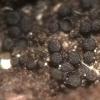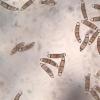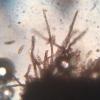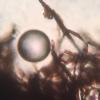
21-04-2019 21:40
 Joop van der Lee
Joop van der Lee
Found on cow dung.Measurements of the perithecia a

21-04-2019 12:06
Me mandan el material desde Galicia, recolectado

20-04-2019 10:47
me envian esta muestra recolectada en madera de eu

12-04-2019 14:11
 Michel Hairaud
Michel Hairaud
Bonjour, Voici une Helotiale manifestement liée

20-04-2019 05:16
Roland LabbéBonjour ! Voici un anamorphe inconnu de nous, Sp

16-04-2019 15:10
HelloCan someone help with this found on a dead/dy

14-04-2019 16:53
 Marc Detollenaere
Marc Detollenaere
Dear forum, On the bark of Larix I found some som

13-01-2019 21:29
Ethan CrensonI find this unknown (to me) asco in the same locat
Chaetosphaerella ?
Ethan Crenson,
11-04-2019 06:53
From New York City last weekend, growing on an old Pyrenomycete (Eutypa, probably) I think this is Chaetosphaerella. The small clusters of black fruiting bodies seem somewhat flattened at the apex. They are seated in a dense brown subiculum. I did not see any asci in any of my mounts. Spores are 3-septate, brown with hyaline end cells and guttules in the two inner cells, usually curved. They measured 24-29 x 6-7µm. I'm uncertain if I saw any conidia-- in the final photo there is a bowling-pin shaped brown cell that has two guttules.
Could this be C. fusca or C. phaeostroma? Does the difference come down to the conidia?
Thank you in advance for your help.
Andrew N. Miller,
11-04-2019 14:45

Re : Chaetosphaerella ?
This is C. fusca. The difference is whether or not the ascomata become collabent and the size of the ascospores (longer in C. phaeostroma).
https://www-s.life.illinois.edu/pyrenos/records/show_by_page?page=24
Andy
https://www-s.life.illinois.edu/pyrenos/records/show_by_page?page=24
Andy
Ethan Crenson,
11-04-2019 17:26
Re : Chaetosphaerella ?
Andy, thank you for your help!




